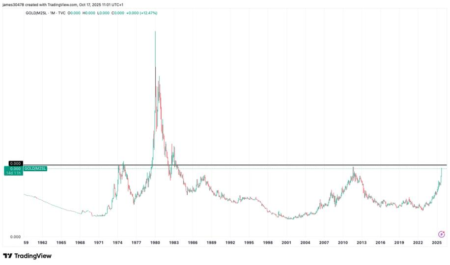Bitcoin’s Short-Term Outlook: Assessing BTC at $105,000 Amidst U.S. Fiscal Trends
As Bitcoin hovers around the $105,000 mark, many investors may perceive a bleak outlook for the cryptocurrency. However, underlying U.S. fiscal trends might paint a more optimistic picture for potential market movements. Recent reports from CNBC indicate that the U.S. Treasury achieved a remarkable $198 billion surplus in September 2025, marking a record high for that month. This impressive financial performance contributes to a notable reduction in the fiscal deficit, now down to $1.78 trillion—a decrease of about $41 billion (2.2%) from 2024.
The Role of Tariffs in the Surplus
Typically, September is a month that witnesses a fiscal surplus largely due to tax payments. However, this year’s surplus can be attributed to an additional factor: tariffs implemented by President Donald Trump in April. The tariffs generated approximately $30 billion in revenue during September, accounting for nearly half of the revenue anticipated for the entire fiscal year. Such substantial earnings are crucial, especially when considering the soaring interest payments on the U.S. national debt of $38 trillion, which have now surpassed $1.2 trillion annually.
Rising Interest Payments Impacting Federal Spending
In September alone, net interest payments totaled $37 billion, ranking as the fourth-largest federal expenditure following Social Security ($133 billion), health spending ($94 billion), and national defense ($76 billion). The heightened revenue from tariffs indicates a robust commitment to trade strategies, possibly prompting investors to reevaluate their positions on risk assets. The previous trade tensions, notably referred to as the April “tariff tantrum,” may serve as a precursor to current market reactions.
Shifts in Investment Strategies
In light of these fiscal developments, investors may be inclined to pivot from high-risk assets like Bitcoin to safer havens such as bonds and gold. The current surging interest payments could introduce volatility in the cryptocurrency market as traders seek perceived safer alternatives. Additionally, potential exacerbations in trade tensions might further fuel inflationary pressures, although the Federal Reserve anticipates any price increases to be transient.
Federal Reserve’s Approach to Interest Rates
The Federal Reserve maintains a current interest rate of 4.00% to 4.25%, with market projections indicating a potential reduction of 50 basis points in 2025. This could lead to a benchmark rate adjustment to 3.50% – 3.75%. The impact of any forthcoming rate cuts on risk assets remains uncertain, as investors grapple with the implications of shifting fiscal policies and the evolving landscape of global trade.
Future Projections for Bitcoin
The interplay between U.S. fiscal health and Bitcoin’s price could influence its trajectory in the near future. If economic indicators continue to strengthen, especially through increased revenue from tariffs and a favorable deficit outlook, there may be room for increased confidence in Bitcoin as an investment. Conversely, rising interest payments and trade tensions could create fluctuations in Bitcoin’s value, mirroring past market behaviors. Therefore, while Bitcoin’s immediate outlook may appear uncertain at $105,000, understanding underlying economic factors is essential for informed investment decisions going forward.
In conclusion, as the cryptocurrency market assesses its current positioning, investors would do well to keep an eye on the broader economic indicators that could significantly impact Bitcoin’s value. The evolving fiscal landscape could either stabilize the cryptocurrency’s price or lead to increased volatility, highlighting the need for strategic, data-driven investment approaches in this ever-changing market.

















